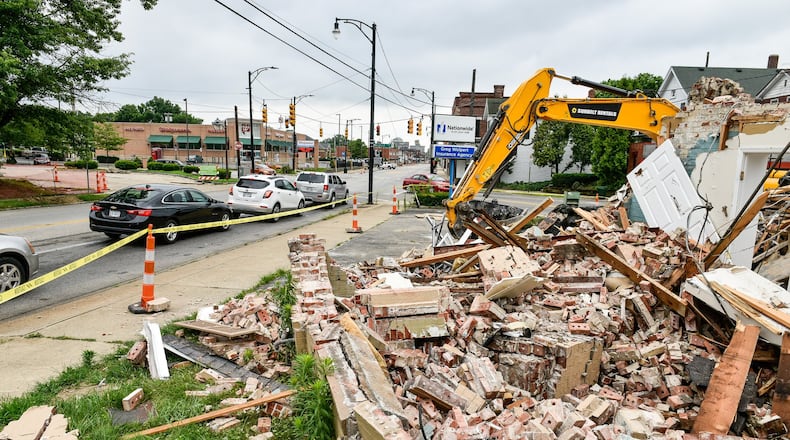There were more than a thousand online ads for truck drivers in June, according to the Ohio Department of Job and Family Services. For registered nurse openings, there were more than 660 ads.
Construction is making a solid showing, as well. When Indeed.com released its 2018 list of the best U.S. jobs in March, construction was well represented, claiming 10 of 25 spots on the list.
Building the future
John Danis, of Danis Building Construction, said that in a busy era for construction firms, skilled workers are needed as soon as possible to fill a shortage.
To fill the industry’s need, existing workers are “mostly just working overtime,” Danis said.
“We can’t find the people,” he said. “You need 10 guys times eight hours a day and we only have eight (guys) so we work 10 hours a day.”
A full 80 percent of construction firms report having a hard time filling hourly craft jobs, according to an industry-wide survey released last week by the Associated General Contractors of America.
“Labor shortages in the construction industry remain significant and widespread,” Ken Simonson, AGC’s chief economist, said in a statement. “The best way to encourage continued economic growth, make it easier to rebuild aging infrastructure and place more young adults into high-paying careers is to address construction workforce shortages.”
That’s what companies say they’re trying to do — talk with high school students, their parents, teachers and guidance counselors.
“We are investing resources that we’ve never invested before in the area of marketing,” said Matthew Szollosi, executive director of ACT (Affiliated Construction Trades) Ohio, a non-profit established by the Ohio State Building and Construction Trades Council, with union affiliates that represent more than 94,000 trades workers.
Construction companies are busier than they have been in years.
“The industrial development that we’re seeing along with the heavy highway work … is virtually unprecedented,” Szollosi said. “We’re very very thankful for the opportunity to go to work every day.”
But those jobs can’t be completed without skilled workers.
“You can’t come in off the street and be a carpenter, a cement finisher, a plumber or an electrician, right away,” Danis said. “You need training and, in some cases, four or five years of it.”
In the immediate term, there are a record number of apprentices enrolled in four- and five-year trades education programs, Szollosi said.
“We are investing extremely heavily in apprenticeship programs,” he said. Statewide, ACT Ohio will invest nearly $60 million in apprentice training statewide.
That’s helping, to some degree, make up for a shortage that came about during the last recession, when many workers exited the construction industry, Danis said. What makes the situation so dire right now is an existing aging workforce is “just aging out right now,” he said.
“You combine those two things and there’s a whole lot more people leaving the industry than coming into the industry,” Danis said.
ACT Ohio has seen apprentices top out with annual pay reaching six figures after five or six years, Szollosi said. “At this juncture right now, overtime is plentiful,” he said.
Pushing pay up may be one way to draw workers to these professions, said Amy Hanauer, executive director of the labor-focused Policy Matters Ohio think tank.
“Historically, when employers really had trouble filling jobs, the lengths they went to do to recruit new workers — they raised wages, there were often clear career ladders so workers knew it was worth putting in the time to acquire some special skills,” Hanauer said.
Today, some employers perhaps have become used to the idea that they don’t have to raise wages or offer training, she said. That idea is outdated, she argues.
Of the 10 most common occupations in Ohio, many pay less than $22,000 or $23,000 a year, she said.
“Those are wages that are pretty tough to get by on these days,” Hanauer said.
The work isn’t easy. Apprentices will work at construction sites 40 hours a week under the supervision of a journeyman, then attend multi-hour classes one or two evenings a week, Szollosi said.
But the long-term goal is to open eyes, breaking the stereotype that students have no choice but to commit four or more years to a college.
“We’re doing everything we can to reach out to the guidance counselors across the state,” Szollosi said.
“We’re still finding good people, but it’s getting harder and harder,” Niekamp said.
Industry representatives visit high schools and vocational schools across the state to discuss the benefits of a career in a construction-related trade, but Danis said he does not believe that is talked about as much as it could be.
“There are some excellent trade schools around here … they just can’t get people in them. I don’t know why,” he said.
Health care
Also growing is the demand for registered nurses. In fact, employment for nurses, nurse practitioners and related fields is expected to grow 31 percent between the years 2014 and 2024, according to the U.S. Bureau of Labor Statistics.
Like the rest of the nation, West Chester Hospital is looking to fill vacant nursing positions, said Kathie Hays, chief nursing officer, West Chester Hospital.
“Our greatest need is in specialty areas,” Hays said. “We are looking to take experienced nurses and train them in the specialty areas of obstetrics, special care nursery, medical/surgical stepdown care and surgery. We’re a small hospital, but we offer all of the specialties that larger hospitals offer, drawing from the academic expertise that our partnership with the University of Cincinnati allows us.”
West Chester Hospital was named a Top Workplace by Greater Cincinnati and the state of Ohio publications year after year. In 2017, it achieved Magnet status, the nation’s highest honor in nursing excellence.
“We offer a Clinical Ladder program for career advancement and implement a strong shared governance model,” Hays said. “That’s crucial for our nurses—that there’s empowerment at the staff level.”


